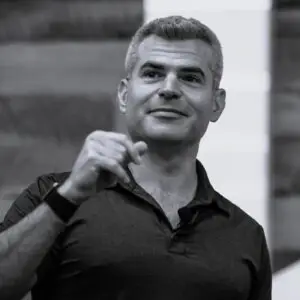A Fractional CTO provides part-time technology leadership to help businesses overcome tech challenges without the high cost of a full-time executive. Here are 7 clear signs you might need one:
- No Clear Tech Strategy: Struggling with outdated systems, inefficiencies, or missed opportunities? A Fractional CTO can create a roadmap aligned with your business goals.
- Growth Bottlenecks: Scaling issues like overloaded systems or poor integrations slowing you down? They can optimize your architecture for growth.
- Outdated Systems: Legacy tech causing downtime, security gaps, or compliance issues? A Fractional CTO modernizes your stack.
- No Tech Leadership: Lack of technical direction leading to missed deadlines and poor team performance? They provide expert guidance and align teams.
- Falling Behind on Trends: Outdated tools or missed innovations hurting your competitive edge? They integrate cutting-edge solutions seamlessly.
- Security Risks: Facing data breaches or compliance challenges? They strengthen your digital defenses and ensure legal compliance.
- Full-Time CTO Costs Too Much: Can’t afford $250K+ annually for a full-time CTO? Fractional CTOs offer high-level expertise at a fraction of the cost.
Quick Comparison: Full-Time vs. Fractional CTO
| Feature | Full-Time CTO | Fractional CTO |
|---|---|---|
| Annual Cost | $250K–$600K+ | $60K–$150K |
| Flexibility | Long-term commitment | Part-time, scalable |
| Onboarding Time | Extensive | Minimal |
| Key Benefits | Full-time oversight | Cost-effective, targeted expertise |
A Fractional CTO is ideal for businesses needing tech leadership without the financial burden. They bring strategic direction, solve tech challenges, and help you scale efficiently. Read on to see how they can transform your business.
Top 5 Reasons to Hire a Fractional CTO Today
Sign 1: Missing Technology Direction
When there’s no clear tech strategy, businesses often find themselves making reactive choices. This can lead to outdated systems, inefficiencies, and missed opportunities. The result? A hit to productivity, higher costs, security risks, and a struggle to stay competitive.
Here’s how the lack of a technology direction affects key areas:
| Impact Area | Consequence | Business Effect |
|---|---|---|
| Daily Operations | Slower task completion, system crashes | Lower productivity, frustrated employees |
| Cost Management | Rising maintenance and repair costs | Higher operational expenses |
| Security | Weak protection against threats | Increased vulnerability to cyberattacks |
| Innovation | Limited exploration of new tech | Loss of competitive edge |
| Employee Retention | Frustration with outdated tools | Higher turnover rates |
"Organizational culture that is high-trust and emphasizes information flow is predictive of software delivery performance and organizational performance in technology".
These challenges demand a structured approach, and that’s where a Fractional CTO can step in with a clear roadmap.
Building a Tech Roadmap
A Fractional CTO crafts a tailored technology strategy that aligns with business goals, ensures scalability, and keeps costs in check. Take Greg Brockman’s work at Stripe, for instance. As a part-time CTO, he designed the company’s server architecture and internal systems, enabling Stripe to securely handle billions in transactions while supporting rapid user growth.
Here’s how a Fractional CTO builds a roadmap:
- Technology Audits: Review current systems to spot inefficiencies.
- Strategic Alignment: Make sure tech initiatives directly support business objectives.
- Performance Metrics: Define clear benchmarks to track progress.
- Security Measures: Strengthen cybersecurity across the board.
With global digital transformation spending expected to hit $2.5 trillion in 2024, having a clear tech roadmap is no longer optional. As Michael Panarella from Forbes Council puts it, "Technology’s impact on your business can be measured by how well it fuses with your strategy and culture".
Sign 2: Growth Bottlenecks
Technical hurdles can hold back business growth. Research shows that companies with clear tech strategies are 30% more likely to hit growth targets, yet nearly half of tech startups face budget issues, and 60% struggle with vendor management during scaling.
Problems such as overloaded systems, outdated platforms, and poor integration can lead to slow response times and frequent downtime. These challenges make scaling a tough task. Take Etsy as an example: during the Covid-19 pandemic, they scaled operations to handle a 208% increase in buyers (from 46.35 to 96.3 million) and a 288% rise in sellers (from 2.6 to 7.5 million). Without the right leadership, such rapid growth could have overwhelmed their platform.
"For SMEs, the future of work lies in the strategic use of fractional and freelance IT and tech professionals." – BusinessCloud
Tackling Technical Growth Challenges
Removing these barriers is essential to align your technology with your business goals. A Fractional CTO can bring the expertise needed to:
- Migrate to the Cloud: Shift to flexible, on-demand cloud platforms.
- Optimize Performance: Use monitoring tools to improve system efficiency.
- Upgrade Architecture: Build scalable systems to handle growing complexity.
For instance, Gallop Technology Group worked with a fintech startup to revamp its entire system architecture. With a Fractional CTO at the helm, the company eliminated downtime and scaled smoothly, setting the stage for further growth.
"Fractional CTOs are catalysts for digital transformation. Their expertise, adaptability, and strategic thinking empower businesses to thrive in the digital age." – Gallop Technology Group
Effective technical leadership makes a measurable difference. Companies with a clear technology roadmap are 50% more likely to achieve their growth goals. A Fractional CTO can also implement capacity planning, ensuring your infrastructure scales with your business needs while keeping costs in check.
Sign 3: Old or Mismatched Systems
Relying on outdated systems can disrupt operations and limit growth. Consider this: 82% of companies experienced unplanned downtime in the last three years, leading to a staggering $50 billion in annual losses. On top of that, employees lose an average of 46 minutes per day dealing with outdated technology issues.
Legacy systems often bring several problems:
- Security gaps: Poorly patched systems make organizations over seven times more susceptible to ransomware attacks.
- Productivity setbacks: Outdated tools slow down daily operations.
- Compliance headaches: Older systems may no longer meet current regulations.
- Integration challenges: Disconnected systems make communication and collaboration difficult.
The rise of personal devices and IoT adds another layer of complexity. With 67% of employees using their own devices for work and projections of 29 billion connected IoT devices by 2030, ensuring security and seamless integration is no small task. These issues highlight the importance of a well-planned upgrade – a challenge a Fractional CTO is well-equipped to tackle.
Updating Your Tech Stack
Fixing legacy system issues requires more than quick fixes or temporary solutions. A Fractional CTO can bring a clear, strategic approach to modernizing your infrastructure, ensuring measurable improvements in performance and outcomes. For instance, in 2020, a sustainable electronics startup partnered with a Fractional CTO to overhaul its infrastructure. The result? A 25% reduction in costs and a 30% faster product development cycle.
Here’s how modernization can address specific challenges:
| Area | Challenge | Solution |
|---|---|---|
| Security | 53% of connected medical devices have critical vulnerabilities | Continuous vulnerability monitoring and timely patching |
| Integration | Disconnected systems creating data silos | Implement modern integration layers for unified data flows |
| Scalability | Systems unable to support growth | Adopt cloud-based solutions with flexible architecture |
| Efficiency | Manual processes slowing operations | Automate workflows to speed up and simplify tasks |
Strategic modernization not only solves these issues but also positions your business for long-term success. A Fractional CTO ensures these upgrades align with your goals while minimizing disruptions.
sbb-itb-4abdf47
Sign 4: No Tech Leadership
Outdated systems and misaligned strategies can slow progress, but the lack of dedicated tech leadership can completely derail technical initiatives. Without strong tech leadership, projects often face higher costs and greater risks. In fact, only 6% of director positions are held by individuals with STEM-related qualifications, highlighting this gap.
Here’s how the absence of technical leadership can affect your business:
| Impact Area | Issue | Business Risk |
|---|---|---|
| Project Management | Missed deadlines, budget overruns | Higher operational costs |
| Technology Strategy | Poor tech stack decisions | Limited scalability |
| Team Performance | Lack of direction and standards | Lower productivity |
| Innovation | Narrow technical perspective | Falling behind competitors |
Research shows that leaders in the bottom 10% for technical skills rank only in the 12th percentile for overall leadership effectiveness. This demonstrates how essential technical expertise is for thriving in today’s business landscape.
"Organisations which don’t make good use of technology lag their peers, and organisations without great technical leaders struggle to make good use of technology." – David Knott
The Role of Expert Guidance
Bringing in a Fractional CTO can significantly improve technical capabilities without the expense of hiring a full-time executive. They provide value in several critical areas:
- Strategic Alignment: Fractional CTOs ensure tech plans are in sync with business objectives by conducting targeted audits and making precise adjustments.
- Team Development: They implement effective workflows, agile methodologies, and documentation practices, giving teams clear direction and improving overall performance.
"Teams need leadership and direction. Direction–defining the problem the team is chartered to solve–usually comes from management. But leadership comes from within the team and from all team members." – Esther Derby
- Investment Appeal: Startups with experienced tech leaders are more attractive to investors. Fractional CTOs help optimize fund use through clear planning and regular progress reviews.
This kind of leadership bridges the gap between strategy and execution, helping businesses tackle their toughest challenges.
Sign 5: Falling Behind on Tech Trends
Outdated technology isn’t just inconvenient – it can seriously harm your business. Studies reveal that 46% of employees experience regular software issues, and 32% of customers stop engaging with brands after a single bad experience. Real-world examples like the 2017 WannaCry ransomware attack, which caused over 19,000 canceled appointments at the UK’s National Health Service, and Equifax’s data breach due to unpatched systems, highlight the dangers of neglecting tech updates.
| Impact Area | Business Risk | Potential Consequences |
|---|---|---|
| Customer Experience | Poor service delivery | Loss of customer loyalty |
| Operations | System inefficiencies | Higher operational costs |
| Security | Vulnerability to attacks | Data breaches and compliance issues |
| Market Position | Competitive disadvantage | Loss of market share |
"The strategic need for modernization is not just about keeping with the latest trends; it is about maintaining competitiveness, ensuring cost-effectiveness, maximizing return on investment (ROI), and managing risks effectively to guarantee long-term success." – Stratpoint Technologies
Staying Current with New Tech
To tackle these risks, businesses need a Fractional CTO who can assess current systems and integrate new technologies effectively. With global digital transformation spending expected to hit $3.9 trillion by 2027, having expert advice is more important than ever.
Take T-Mobile, for example. By implementing Salesforce across all its channels, the company enhanced customer satisfaction and reduced service times. Netflix also made a game-changing move by switching to a microservices architecture, enabling real-time data processing and personalized recommendations.
"Seamless technology integration is all about bringing new technology into your existing systems in a way that feels natural and unobtrusive." – Trio
Here’s how a Fractional CTO can help:
- Evaluate Current Systems: Conduct in-depth audits to pinpoint outdated tech and potential risks.
- Create Implementation Plans: Develop step-by-step strategies to bring in new technologies without disrupting daily operations.
- Support Change Management: Provide training and support to ensure teams can adapt smoothly to new tools.
Sign 6: Security and Legal Risks
Security breaches and compliance violations can threaten the survival of any business. A staggering 82% of breaches involve human error. In the UK alone, 90% of all breaches reported to the Information Commissioners Office in 2019 were caused by end-user mistakes.
Internal threats also play a major role, with 53% of companies reporting insider attacks within a single year. Without strong technology leadership, these risks can spiral into costly disasters.
| Risk Category | Impact | Consequence |
|---|---|---|
| Data Breaches | Financial loss | Legal penalties, reputation harm |
| Compliance Violations | Regulatory fines | Business operations disrupted |
| Insider Threats | Data compromise | Loss of intellectual property |
| Employee Errors | System vulnerabilities | Increased security incidents |
These examples highlight the importance of having a security strategy led by experienced professionals.
Strengthening Security Measures
A Fractional CTO can play a key role in strengthening your digital defenses while aligning security efforts with broader business objectives. For example, after a healthcare startup suffered a data breach, its Fractional CTO introduced encrypted communications and multi-factor authentication, helping rebuild patient trust.
Here’s how a Fractional CTO can enhance your security framework:
- Deploying Advanced Protection
Implement systems like Endpoint Detection and Response (EDR) and Security Information and Event Management (SIEM) to quickly detect and respond to threats. - Ensuring Compliance
When expanding into Europe, a Fractional CTO designed systems to handle data consent, breach notifications, and customer data requests, ensuring GDPR compliance. - Fostering a Security-First Culture
Create an environment where employees view security as a shared responsibility. This mindset reduces risks and builds resilience.
"A security-first mindset goes beyond regulatory checkboxes and forms the backbone of a resilient organization. The CTO’s role encompasses more than technological oversight – it involves cultivating a culture where every employee understands that security is a shared responsibility." – 7CTOs
Small businesses often lack dedicated compliance teams, leaving them exposed to regulatory violations. A Fractional CTO’s expertise in frameworks like NIST, ISO/IEC 27001, and CIS controls ensures your business stays protected without sacrificing efficiency. They handle security audits, manage vendor relationships, and maintain incident response plans to address breaches effectively.
Sign 7: Full-Time CTO Cost Barriers
For many businesses on the rise, hiring a full-time CTO can be a financial hurdle. In the U.S., a full-time CTO typically earns between $230,000 and $380,000 annually. When you add benefits – like health insurance, retirement plans, and stock options – total compensation can jump by 20–30%, often exceeding $450,000 per year.
| Cost Component | Full-Time CTO | Fractional CTO |
|---|---|---|
| Annual Base Cost | $230,000 – $380,000 | $156,000 (2 days/week) |
| Benefits | 20–30% of salary | None |
| Recruitment Costs | Yes | Minimal |
| Training & Onboarding | Extensive | Minimal |
| Commitment Length | Long-term | Flexible |
Cutting Costs with Fractional CTOs
Fractional CTOs bring high-level expertise without the hefty price tag. With hourly rates ranging from $200–500, a fractional CTO working two days per week costs around $156,000 annually. This can save businesses up to $271,000 compared to hiring a full-time CTO.
Take CTOx’s "CTOx Engaged" plan as an example. For $7,000 per month, businesses gain access to essential services like technology strategy development and team recruitment guidance – without the overhead of a full-time executive.
Here’s how companies save with fractional CTOs:
- No benefits costs: Skip expenses for health insurance, retirement plans, and stock options.
- Lower overhead: Avoid paying for extra office space or equipment.
- Flexible engagement: Scale services up or down based on your needs.
- Reduced risk: Avoid costly hiring mistakes that could disrupt productivity and morale.
These savings allow businesses to redirect funds toward other strategic priorities.
For example, WiserBrand worked with a sustainable electronics startup launched in 2020. By using a fractional CTO, the company cut infrastructure costs by 25% and sped up product development by 30%.
Mid-sized SaaS companies often report annual savings between $115,000 and $271,000 by opting for a fractional CTO instead of hiring full-time, freeing up resources for other growth opportunities.
Do You Need a Fractional CTO?
Deciding whether to bring in a Fractional CTO depends on your company’s tech needs and current stage of growth. If you’re facing technical hurdles but lack the budget or need for a full-time CTO, this could be the right solution for you.
Common Warning Signs
Here are some signs that it might be time to consider fractional CTO services:
| Warning Sign | Business Impact | Solution Offered |
|---|---|---|
| Unclear Tech Direction | Wasted resources, missed chances | Strategic roadmaps |
| Growth Bottlenecks | Scaling and performance issues | Scalable architecture |
| Outdated Systems | Security and efficiency problems | Tech stack improvements |
| Lack of Tech Leadership | Poor decisions, misaligned teams | Expert guidance |
| Security/Compliance Gaps | Legal and data risks | Security frameworks |
These issues highlight how expert tech leadership can address critical challenges and keep your business moving forward.
"For SMEs, the future of work lies in the strategic use of fractional and freelance IT and tech professionals." – BusinessCloud
Steps to Hire a Fractional CTO
If you’re ready to move forward, here’s how to make it happen:
- Identify Your Needs
Pinpoint the challenges you’re facing and define your goals. For example, CTOx offers a "CTOx Engaged" plan for $7,000 per month, which includes services like team recruitment and KPI reporting. - Evaluate Candidates
Look for professionals with the following skills:- Strategic technology planning
- Experience with business growth strategies
- Budget management for tech projects
- Strong communication abilities
- A proven track record with similar companies
- Set Clear Expectations
Focus on outcomes rather than hours worked. Fractional CTOs typically charge monthly retainers between $10,000 and $25,000, which is often more cost-effective than hiring a full-time CTO.
"Choosing between a full-time and fractional CTO depends on your company’s stage, expertise needs, and budget. A fractional CTO offers diverse skills for specific challenges, driving innovation and growth." – Priyanka Sharma, Software Engineer
With digital transformation spending expected to hit $3.9 trillion by 2027, having the right guidance can play a critical role in determining your competitive edge.







